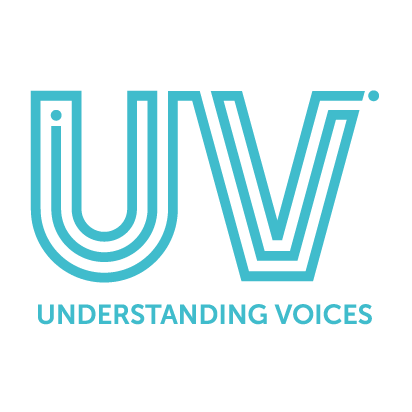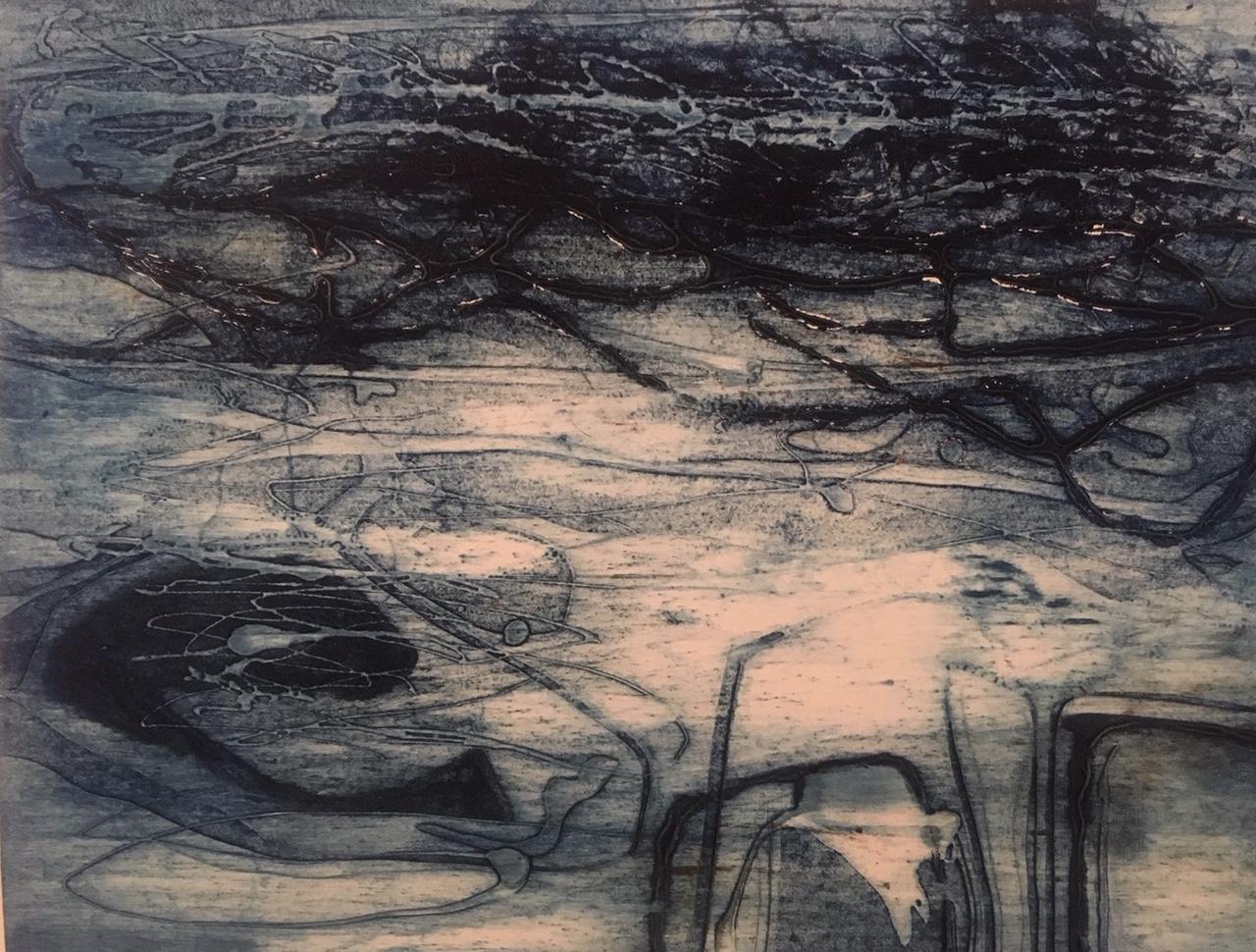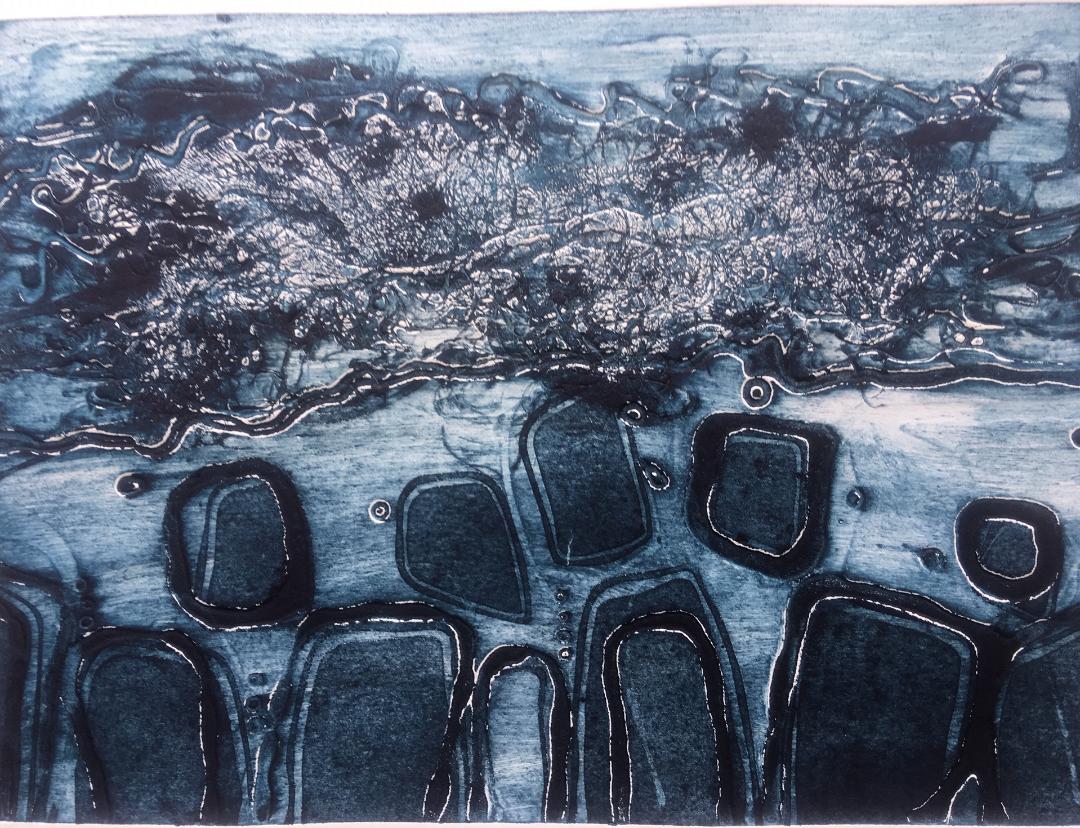Ruth
Ruth Lafferty lives in Leeds with her partner, and darling wolfhound, Nesta. She is studying at Leeds Arts University for an MA in creative practice after concluding her career in psychotherapy when she started hearing voices and seeing things and people that others can’t see. She is now thriving alongside her voices, through forming safe and nourishing relationships and pursuing a creative practice.
Please tell us about this piece of work. How is it linked to your experience of hearing voices?
These two prints were an attempt to illustrate some aspect of the energy related to the experience of hearing voices. The first one, Chaos I, was an initial experiment (as all my work is!) to see if there could be a connection between the process of making whilst dialoguing with my voices. A collaboration if you like. It therefore includes some image making from me in trying to illustrate something of the energy and quality of some of the more turbulent interactions I have with some of my voices, using gestural line and materials that can communicate the “texture” of those interactions. Within that is the frustration my voices have with me in trying to communicate with me, especially when I’m not “getting it”. So the gestures are literally drawn from those interactions. They are more evident in the top half of the image. There are also some shapes that originally I thought were random abstractions of the gestural lines that started to emerge. These were drawn with resin and carborundum, such as the shape at the bottom left of the image. Once printed it resembles a bit of a sea creature with a huge mouth. Some of my senses of voices are that they can be very consuming of my space, my energy and sometimes my sense of self. Was it random or a subconscious statement to them, or to a couple of voices in particular? It did offer the opportunity to talk to my voices about this experience and to negotiate with them about being less intense if in return I listened more to them. I also relate this metaphor of being engulfed to previous experiences that I believe caused dissociation, splitting and the emergence of my voices. It speaks of both.
The colour is a favourite of mine, a blend of Prussian and indigo blues. There is a smudge of red too. This is quite an important colour in terms of connecting with a vitality of life, blood, heat, anger but also love. I only added a smudge as a kind of anchor to remind me that even in the throws of the most heated exchanges, flashbacks and strong feelings, I need to and try to hold to hope and light. Therefore the process of constructing a plate to print from and the “inking up” or colouring of the plate is an opportunity to illustrate a snapshot of current experience, but also to actively add in things that help remind me of where I want to go in my life journey and in my relationships with my voices.
The constructing of the plate is a record of where I am but also offers agency and reminders that I construct my reality every day, as we all do, if using that way of thinking. It also offers, therefore, the reminder that I can also deconstruct past narratives of experience and look at them with a new perspective with new insight, new materials within the plate making, new forms, or altered favourite forms. Life evolves, as do images from one to another. The constructions and deconstructions that also spark conversations and sometimes make me stop and listen to my voices.
How (if at all) does making art help you cope with or explore your voices?
Making art is an authentic part of my way of life and always has been. In my early life, I think I used making clothes and working with colour to disappear from the stress around me. I didn’t hear voices then but I did struggle with anxiety, trust in the world and depression. Making things was a bridge, I think, between dissociating and re-connecting. I think it is because making something is primal and can do something to a sense of efficacy in the world, can build a bit of confidence, pleasure, dignity, but also the ability to make a mark on the tangible world. Connect the invisible with something that exists in a concrete way. It was a way of withdrawing safely and reconnecting safely. Having established this pathway, it is a thing that my voices are familiar with and so they can be very peaceful when I’m making art. I’m being syntonic with who I am so they endorse or don’t need to warn me of risk of doing something unhealthy (I believe the role of my voices is to protect me and ensure I am being true to myself) I can often chat with them whilst I’m making and they can chat back.
On a day when they have been triggered by something not related to my making I find it very hard to focus on my art, I’m too agitated or shaky. Sometimes I can start something in a shaky way and out of it a conversation emerges and something can settle but that is often a slow process but if I can stick with it, something progressive in my understanding can occur. The outcome is more about my relationship with my voices rather than a resolved piece of work but it can inspire another piece when I’m more able to focus.
Some stages of work when I’m making a printing plate is primarily mechanical. If I’ve drawn the image and just cutting the plate, following the lines I’ve already made, I can be more meditative and can either choose to defer listening or engage with them. If they get very demanding I can stop and listen. It’s a learning to live with them alongside an occupation that is also important. It helps me learn to cope with them and maybe, because making art has become so important to me, I can be stronger in negotiating with them. I increase my tolerance of them and they, in turn, increase their tolerance of me being more assertive, which is what they want!!!! It can sound circular and it is but it’s a journey of slowly spiralling upward to greater self-expression and resilience. I believe that anyway!
What role do your voices play in the creative process? Do they inspire you or do they sometimes ‘get in the way’?
On an ordinary day when I can truly focus on making in a mindful way, my voices are fairly calm. If they are more vocal, I can tolerate it to a degree and keep working. They don’t usually comment on the work directly, but the creative process often leads to exploring difficult memories. Spontaneous art often accesses the unprocessed aspects of lived experience including trauma, particularly if I’m working in a gestural and spontaneous way rather than constructing an image from a photograph or montage. A mark making and use of colour can either be a direct expression of experience or remind me or remind my body of those experiences. This is usually what voices react to as opposed to whether I’m doing a “good” or “bad” piece of work. I can start to listen or carry on with the work unless the voice or voices get too agitated and I lose my flow. I’m learning to stop and listen to what it is they are trying to comment on or shout about. Sometimes, just getting the emotion or visceral sensation out with mark making or colour is sufficient and sometimes they calm down if I can make the link with reclaiming something lost from the triggered experience. Reclaiming a bit of dignity, losing some shame, speaking to myself and my voices with compassion. It can be a long process!!! I have learnt to ride, to not ignore the insulting aspects of my voices. I have learnt through voice dialogue and trying to decode messages that insults are usually about warning. If I’m thinking and making, and other memories of difficult times intrude I can respond to these in my art work by introducing light and start to rework the narrative of trauma and include the elements that restore balance, without denying the original experience. This in turn helps me to understand what role individual voices play and which voices relate to which experiences. It isn’t that discreet, but some voices are related to specific trauma/overwhelming experiences and emerged to hold the disowned feelings and memories. For example, the voice I know most about is primarily focused on relational protection and particular images that I have made relate to his role and the aspects of relating he wants to protect me from. In the second image above, Chaos II, he became very agitated about how close the stone images were to each other. I talked about a halo of protection that he offers me when I listen to him. We dialogued about that and I included some marks that honoured that role he plays and me accepting his advice. It can be a paradoxical process and it’s hard to articulate. I hope some of that made sense!!
The voices do inspire and block sometimes. The blocking is usually because I haven’t understood something they are trying to tell me. The blocks are frustrating at times and challenge my faith that they are there to protect and promote my wellbeing. I know that chipping away at dialoguing with them either when I’m making art or when I’m with my partner or people I work with will give me the best chance of understanding and resolving the blocks.
What’s your advice to other voice-hearers thinking of using creative activities as a means of coping with or exploring their experiences?
Making things, dancing, writing, day dreaming, creating safe relationships, singing etc. can all be a creative expression of authentic self and I believe we are all born to create every day. It’s one of the essences of being human and sentient. It sometimes feels dangerous. Start small, expect frustration, know it can be a slow process but it can teach you something about yourself as well as being an avenue to express the inexpressible and start unfreezing the static, frozen and hidden experiences that are caught in our viscera and neural pathways. You can be creative at different levels of expression. Making something can sometimes offer unexpected connections with emotion, memories and beliefs about yourself and the world. None of it is wasted or wasteful. It’s you being you. Something that I think all voice-hearers struggle with. It’s not magic and sometimes it’s really hard and frustrating. Come and go with it. Sometimes the desire to create something perfect (defined by others, your voices or an internal perfection driver) can stall things. Aim to make things that are not perfect but an expression of that moment and enjoy the surprises when they occur. Dare to do it and get support or inspiration from trusted others if it feels daunting or dangerous but you still want to do it. Making something and exploring it afterwards with voices can be illuminating and if voices are critical, try and work out why and what they are really wanting to say. You can use making things in so many different ways from distraction to deep resolution of your own personal core issues. It’s like learning a new language to express yourself with that can take you past the verbal. This is perhaps the most important aspect as voices are often predominantly verbal. Take time.


